Related Research Articles

The Second Battle of El Alamein was a battle of the Second World War that took place near the Egyptian railway halt of El Alamein. The First Battle of El Alamein and the Battle of Alam el Halfa had prevented the Axis from advancing further into Egypt.

Operation Compass was the first large British military operation of the Western Desert Campaign (1940–1943) during the Second World War. British, Indian, Commonwealth and Allied forces attacked Italian forces of the 10th Army in western Egypt and Cyrenaica, the eastern province of Libya, from December 1940 to February 1941.

Crusader, in full "Tank, Cruiser Mk VI, Crusader", also known by its General Staff number A.15, was one of the primary British cruiser tanks during the early part of the Second World War. Over 5,000 tanks were manufactured and they made important contributions to the British victories during the North African Campaign. The Crusader tank would not see active service beyond Africa, but the chassis of the tank was modified to create anti-aircraft, fire support, observation, communication, bulldozer and recovery vehicle variants.
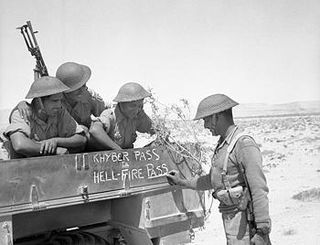
Operation Battleaxe was a British Army offensive during the Second World War to raise the Siege of Tobruk and re-capture eastern Cyrenaica from German and Italian forces. It was the first time during the war that a significant German force fought on the defensive. The British lost over half of their tanks on the first day and only one of three attacks succeeded.

Operation Crusader was a military operation of the Western Desert Campaign during World War II by the British Eighth Army against the Axis forces in North Africa commanded by Generalleutnant Erwin Rommel. The operation was intended to bypass Axis defences on the Egyptian–Libyan frontier, to defeat the Axis armoured forces and to relieve the 1941 Siege of Tobruk.

The infantry tank was a concept developed by the United Kingdom and France in the years leading up to World War II. Infantry tanks were designed to support infantrymen in an attack. To achieve this, the vehicles were generally heavily armoured to allow them to operate in close concert with infantry even under heavy fire. The extra armour came at the expense of speed, which was not an issue when supporting relatively slow-moving foot soldiers.

The Battle of Alam el Halfa took place between 30 August and 5 September 1942 south of El Alamein during the Western Desert Campaign of the Second World War. Panzerarmee Afrika, attempted an envelopment of the British Eighth Army. In Unternehmen Brandung, the last big Axis offensive of the Western Desert Campaign, Rommel intended to defeat the Eighth Army before Allied reinforcements arrived.

The Battle of Gazala was fought during the Western Desert Campaign of the Second World War, west of the port of Tobruk in Libya, from 26 May to 21 June 1942. Axis troops of the Panzerarmee Afrika consisting of German and Italian units fought the British Eighth Army composed mainly of British Commonwealth, Indian and Free French troops.
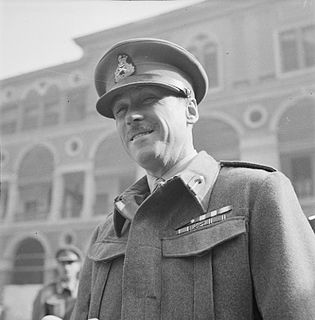
Major-General John Charles Campbell,, known as Jock Campbell, was a British Army officer and a Scottish recipient of the Victoria Cross, the highest award for gallantry in the face of the enemy that can be awarded to British and Commonwealth forces.

The Defence of Outpost Snipe in Egypt, took place in the Second Battle of El Alamein, part of the Western Desert campaign during the Second World War. On the night of 26/27 October 1942, the 2nd Battalion of the Rifle Brigade, with thirteen 6-pounder anti-tank guns and the 239th Battery, 76th Anti-Tank Regiment, Royal Artillery, with six more 6-pounders, was ordered to occupy a desert feature known as Snipe, a small depression in the landscape 1.5 mi (2.4 km) south-west of Kidney Ridge that was suitable for an outpost. Once consolidated, it could be used as a jumping-off point for an advance by the 24th Armoured Brigade.
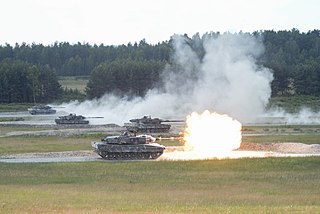
Armoured warfare or armored warfare, mechanised warfare or tank warfare is the use of armoured fighting vehicles in modern warfare. It is a major component of modern methods of war. The premise of armoured warfare rests on the ability of troops to penetrate conventional defensive lines through use of manoeuvre by armoured units.

The Battle of Medenine was an Axis spoiling attack at Medenine in Tunisia on 6 March 1943. The operation was intended to delay an attack by the British Eighth Army on the Mareth Line. The British had been forewarned by Ultra decrypts of German wireless communications and rushed reinforcements from Tripoli and Benghazi before the Axis attack, which was a costly failure. General Erwin Rommel, the commander of Army Group Africa (Heeresgruppe Afrika), could not afford to lose forces needed for the defence of the Mareth Line and the effort was abandoned at dusk that day.
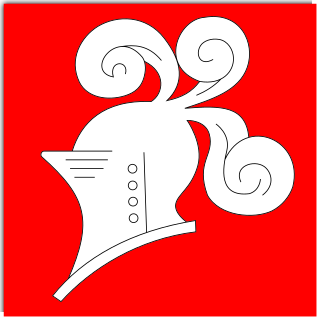
The 2nd Armoured Division was a division of the British Army that was active during the early stages of the Second World War. The division's creation had been discussed since the beginning of 1939, with the intent to form it by splitting the 1st Armoured Division. A lack of tanks delayed this until December 1939. For a short period after its creation, the division had no assigned units until the 1st Light Armoured Brigade was assigned to it from the 1st Armoured Division, and the 22nd Heavy Armoured Brigade from Southern Command.
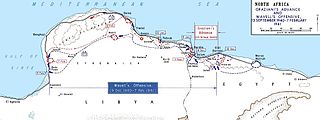
The rapid British advance during Operation Compass forced the Italian 10th Army to evacuate Cyrenaica, the eastern province of Libya. In late January, the British learned that the Italians were retreating along the Litoranea Balbo from Benghazi. The 7th Armoured Division was dispatched to intercept the remnants of the 10th Army by moving through the desert, south of the Jebel Akhdar via Msus and Antelat as the 6th Australian Division pursued the Italians along the coast road, north of the jebel. The terrain was hard going for the British tanks and Combeforce, a flying column of wheeled vehicles, was sent ahead across the chord of the jebel.
3rd Regiment Royal Horse Artillery is a regiment of the Royal Horse Artillery in the British Army. They are currently based at Albemarle Barracks, Northumberland, England.
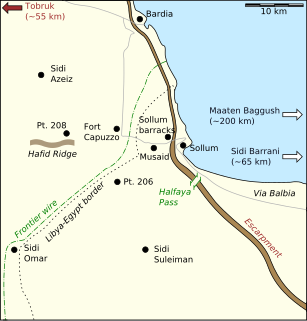
Operation Skorpion from 26 to 27 May 1941, was a military operation during the Western Desert Campaign of the Second World War. The operation was conducted by Axis forces under the command of Colonel Maximilian von Herff and British forces under Lieutenant-General William "Strafer" Gott. A counter-attack was made on British positions at Halfaya Pass in north-western Egypt, which had been captured during Operation Brevity (15–16 May).Unternehmen Skorpion was the second offensive operation commanded by Rommel in Africa.

The Italian invasion of Egypt was an offensive in the Second World War, against British, Commonwealth and Free French forces in the Kingdom of Egypt. The invasion by the Italian 10th Army ended border skirmishing on the frontier and began the Western Desert Campaign (1940–1943) proper. The Italian strategy was to advance from Libya along the Egyptian coast to seize the Suez Canal. After numerous delays, the scope of the offensive was reduced to an advance as far as Sidi Barrani and the engagement of any British forces in the area.

Combeforce or Combe Force was an ad hoc flying column of the British Army during the Second World War, commanded by Lieutenant-Colonel John Combe. It comprised parts of the 7th Armoured Division of the Western Desert Force. The rapid British advance during Operation Compass forced the Italian 10th Army to evacuate Cyrenaica, the eastern province of Libya. In late January, the British learned that the Italians were retreating from Benghazi, along the coast road. The 7th Armoured Division was dispatched to intercept the remnants of the 10th Army by moving through the desert, south of the Jebel Akhdar via Msus and Antelat, as the 6th Australian Division pursued the Italians along the coast road, north of the jebel.

At the start of 1939, the British Army was a small volunteer professional army. At the beginning of the Second World War, 3 September 1939, the British Army was small in comparison with those of its enemies, as it had been at the beginning of the First World War. It also quickly became evident that the initial structure and manpower of the British Army were woefully unprepared and ill-equipped for a war with multiple enemies on multiple fronts. During the early war years the British Army suffered defeat in almost every theatre of war in which it was deployed. But from late 1942, starting with the battle of El Alamein, fortunes changed and the British Army never suffered another strategic defeat, despite some tactical failures.
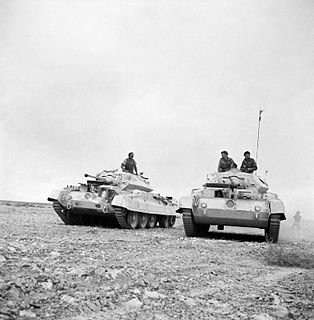
This article on military tanks deals with the history and development of tanks of the British Army from their first use in World War I, the interwar period, during World War II, the Cold War and modern era.
References
- Bailey, Johnathan (1989). Field Artillery and Firepower. Taylor & Francis Group. ISBN 0-203-39582-4.
- Cox, Geoffrey (1987). A Tale of Two Battles: Crete & Sidi Rezegh. London: William Kimber. ISBN 0-7183-0642-2.
- Mead, Richard (2007). Churchill's Lions: A biographical guide to the key British generals of World War II. Stroud: Spellmount. ISBN 978-1-86227-431-0.
- Dando, Neal (2014). The impact of terrain on British operations and doctrine in North Africa 1940-1943 (Thesis). Plymouth University.